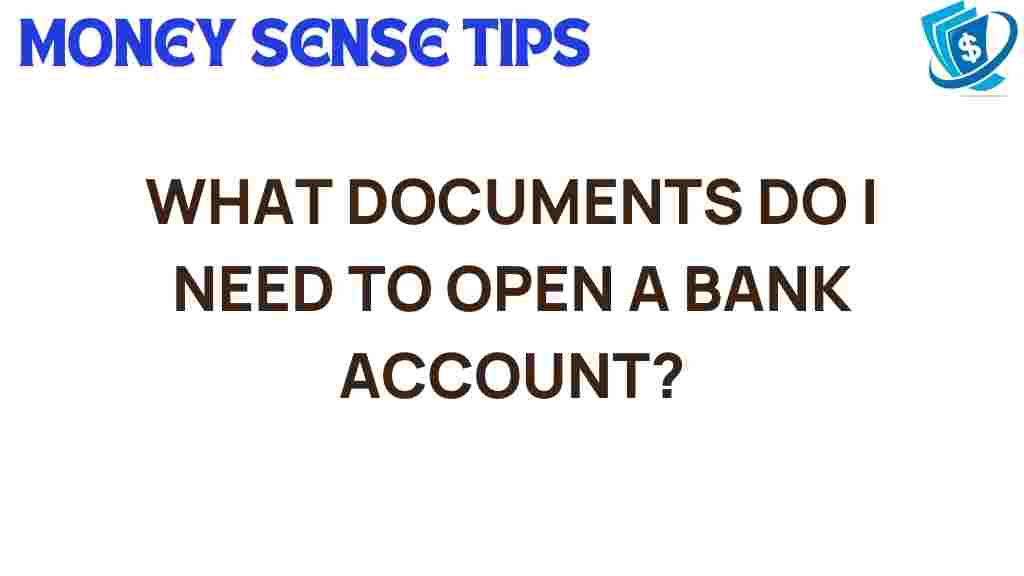Unlocking the Secrets: What Documents Are Needed to Open a Bank Account?
Opening a bank account is a fundamental step in managing your finances, whether you are an individual or a business. However, many people often overlook the required documents necessary for this process. Understanding the opening process and the various account types available can help streamline your experience at financial institutions. In this article, we will explore the essential documents needed for opening a bank account, the importance of customer verification, and some tips to make the process smooth and hassle-free.
Why Opening a Bank Account is Important
A bank account serves as a safe place to store your money while providing you access to various financial products and services. Here are some reasons why having a bank account is essential:
- Security: Your money is protected from theft and loss.
- Convenience: Easily access your funds through ATMs and online banking.
- Financial Management: Track your spending and manage your budget effectively.
- Access to Credit: Establishing a banking relationship can help you qualify for loans and credit cards.
Understanding the Required Documents
When you decide to open a bank account, you will need to provide certain required documents. These documents are essential for financial institutions to verify your identity and ensure compliance with regulations. Below are the typical documents you will need:
1. Identification Documents
Identification is crucial for customer verification. Commonly accepted forms of ID include:
- Government-issued photo ID (e.g., passport, driver’s license)
- Social Security Number (SSN) or Individual Taxpayer Identification Number (ITIN)
- Birth certificate (may be requested for minors)
2. Proof of Address
Your current residence must be verified through documents like:
- Utility bill (electricity, water, gas)
- Lease agreement or mortgage statement
- Bank statements from another financial institution
3. Employment and Income Verification
Some banks may require proof of employment or income. This can include:
- Recent pay stubs
- Tax returns
- Employment letter
4. Initial Deposit
Most financial institutions require an initial deposit to open the bank account. This amount varies by institution and account type.
Steps to Open a Bank Account
Now that you are aware of the required documents, here is a step-by-step guide to help you through the opening process:
Step 1: Choose the Right Bank and Account Type
Before you visit a bank, research various financial institutions to find one that suits your needs. Consider factors such as:
- Fees and charges
- Minimum balance requirements
- Account types available (checking, savings, business accounts)
- Online banking features
Step 2: Gather Required Documents
Compile all the necessary documents mentioned above, ensuring they are up to date and valid. Having everything ready will expedite the process.
Step 3: Visit the Bank or Apply Online
You can either visit a local branch or apply online, depending on the bank’s offerings. For in-person visits, bring your documents, and be prepared to fill out an application form.
Step 4: Complete the Application Form
Fill out the application form with accurate information. The bank will ask for details such as:
- Personal information (name, address, date of birth)
- Employment details
- Desired account type
Step 5: Submit Required Documents
Present your identification, proof of address, and any other required documents to the bank representative. If applying online, you may need to upload scanned copies.
Step 6: Make Your Initial Deposit
Complete the process by making the initial deposit. This can be done through cash, check, or electronic transfer, depending on the bank’s policies.
Step 7: Set Up Online Banking
Once your account is opened, set up online banking to manage your account easily. You can link your account to budgeting apps, making it a valuable tool for financial management.
Troubleshooting Common Issues
Sometimes, the process of opening a bank account can come with challenges. Here are some common issues and how to resolve them:
1. Missing Documents
If you don’t have all the required documents, contact the bank for alternatives. Some financial institutions may accept additional forms of identification or proof of address.
2. Discrepancies in Information
Ensure that the information on your identification matches the details you provide in the application. Any discrepancies can delay the verification process.
3. Initial Deposit Concerns
If you are unsure about the initial deposit requirements, check with the bank beforehand. Some institutions may offer accounts with no minimum balance.
Types of Bank Accounts
Understanding the different account types available can help you choose the right one for your financial needs:
1. Checking Accounts
Checking accounts are designed for daily transactions, providing easy access to your funds through checks, debit cards, and ATMs.
2. Savings Accounts
Savings accounts are ideal for saving money and earning interest. They typically have lower transaction limits compared to checking accounts.
3. Money Market Accounts
These accounts offer higher interest rates and more flexible access to funds but usually require a higher minimum balance.
4. Certificates of Deposit (CDs)
CDs are time deposits with fixed interest rates that require you to keep your money in the account for a specified period.
Conclusion
Opening a bank account is a straightforward process if you are prepared with the necessary required documents. By understanding the opening process and the importance of customer verification, you can navigate the banking system with confidence. Whether you need a checking account for everyday transactions or a savings account for future goals, being informed will help you make the best choices for your financial future.
For more information on financial services and banking essentials, check out this comprehensive guide on banking basics. If you have specific questions about your situation, don’t hesitate to contact your chosen financial institution directly for assistance.
This article is in the category Accounts and created by MoneySenseTips Team
